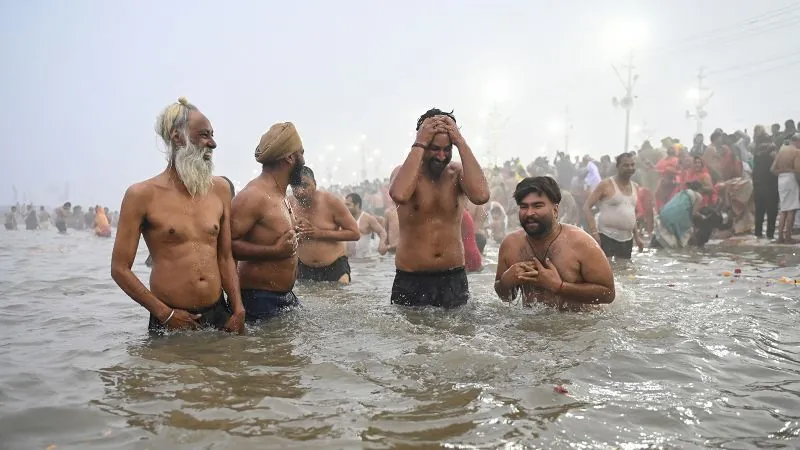
Maha Kumbh Mela: The Unprecedented Spiritual Gathering of Millions in India
2025-01-13
Author: Noah
The Maha Kumbh Mela is officially underway in the northern state of Uttar Pradesh, India, drawing millions of Hindu devotees to partake in one of the largest religious gatherings on the planet. Over the next six weeks, an astounding 400 million attendees are expected to flock to Prayagraj, as they immerse themselves in the sacred waters of the Triveni Sangam, the junction where the holy rivers Ganga, Yamuna, and the legendary Saraswati converge. This event, known as the “festival of the Sacred Pitcher,” holds profound significance for participants, who believe bathing here can cleanse their sins and bring them closer to spiritual liberation.
History and Significance
The Maha Kumbh Mela, held every twelve years, is the grandest version of the Kumbh Mela celebrations that rotate among four cities—Prayagraj, Nashik, Haridwar, and Ujjain—every three years. It is steeped in rich Hindu mythology, tracing back to an ancient tale of gods and demons vying for a pot of elixir symbolizing immortality. The legend asserts that four drops from this pot fell at the locations of today’s participating cities, cementing their spiritual status.
Cultural Impact
With the festival drawing global attention, Indian Prime Minister Narendra Modi has encouraged attendees from around the world to join in this unique cultural experience. In 2017, UNESCO recognized the Kumbh Mela as an “intangible cultural heritage of humanity,” further elevating its international profile. Not just a religious celebration, the festival has also attracted celebrities from Bollywood and Hollywood over the years, emphasizing its cultural significance.
Preparations and Safety Measures
The Chief Minister of Uttar Pradesh, Yogi Adityanath, has already reported that millions have taken the sacred dips in the waters. It's worth noting that Prayagraj was formerly known as Allahabad—a name changed in 2018 to reflect its identity as a spiritual hub. This shift was part of a broader initiative by Modi’s administration to redefine India’s secular landscape with a focus on Hindu heritage.
To accommodate the massive influx of visitors—which often overwhelms the city that typically houses 6 million—significant preparations have been made. Authorities have set up around 160,000 tents, 150,000 toilets, and a drinking water supply system stretching 776 miles (1,249 kilometers). All of these facilities are established in a 4,000-hectare temporary tent city, which equals the area of approximately 7,500 football fields.
Reflecting on past tragedies, such as the crowd crush that led to casualties during the 2013 Kumbh, officials this year have implemented enhanced safety protocols. They’ve established a security perimeter featuring over 1,000 police officers, 2,700 AI-driven security cameras, and for the first time, underwater drones capable of diving up to 100 meters will be deployed to monitor the waters of the Sangam.
Transportation and Infrastructure
As pilgrims predominantly travel by train, authorities have arranged 3,000 special trains and 13,100 train services to ensure smooth transit. Moreover, infrastructure developments, including new flyovers, road corridors, buses, and temporary bridges, have been put in place to better facilitate movement in and around Prayagraj.
Conclusion
Expectations are high as the festival is set to conclude on February 26, marking another chapter in the rich tapestry of traditions and beliefs that make the Kumbh Mela a landmark event in the global religious calendar. Will you be part of this staggering spiritual spectacle? Join the chant of devotion and experience history in the making!









 Brasil (PT)
Brasil (PT)
 Canada (EN)
Canada (EN)
 Chile (ES)
Chile (ES)
 Česko (CS)
Česko (CS)
 대한민국 (KO)
대한민국 (KO)
 España (ES)
España (ES)
 France (FR)
France (FR)
 Hong Kong (EN)
Hong Kong (EN)
 Italia (IT)
Italia (IT)
 日本 (JA)
日本 (JA)
 Magyarország (HU)
Magyarország (HU)
 Norge (NO)
Norge (NO)
 Polska (PL)
Polska (PL)
 Schweiz (DE)
Schweiz (DE)
 Singapore (EN)
Singapore (EN)
 Sverige (SV)
Sverige (SV)
 Suomi (FI)
Suomi (FI)
 Türkiye (TR)
Türkiye (TR)
 الإمارات العربية المتحدة (AR)
الإمارات العربية المتحدة (AR)